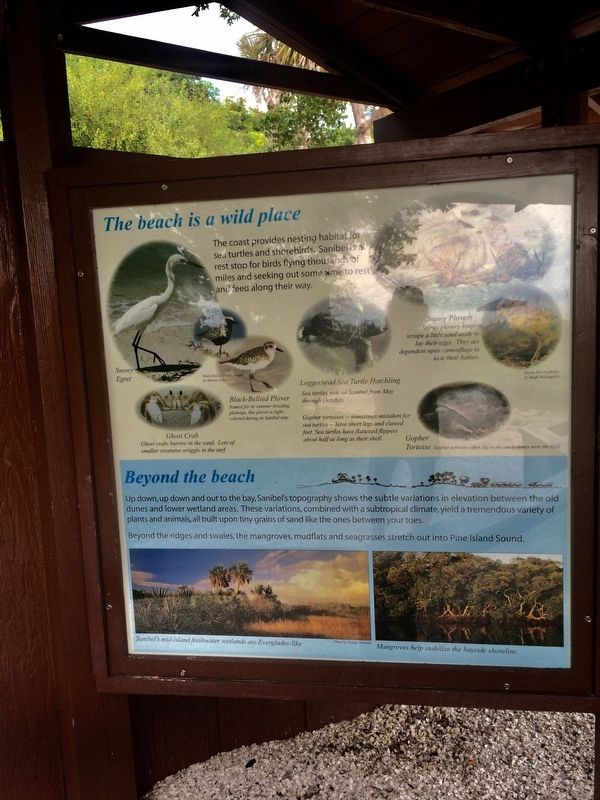Sanibel Island in Lee County, Florida — The American South (South Atlantic)
The Beach is a wild place
Snowy Egret
Ghost Crab
Ghost crabs burrow in the sand. Lots of smaller creatures wriggle in the surf.
Black-Bellied Plover
Named for its summer breeding plumage, this plover is light-colored during its Sanibel stay.
Loggerhead Sea Turtle Hatchling
Sea turtles nest on Sanibel from May through October.
Gopher tortoises--sometimes mistaken for sea turtles--have short legs and clawed feet. Sea turtles have flatten flippers about half as long as their shells.
Gopher Tortoise
Gopher tortoise often dig sandy dunes near the Gulf.
Snowy Plovers
Snowy Plovers simply scrape a little sand aside to lay their eggs. They are dependent upon camouflage to hide their babies.
Snowy Plover photo by Hugh McLaughlin
Beyond the Beach
Up down, up down and out to the bay, Sanibel's topography shows the subtle variations in elevation between the old dunes and lower wetlands areas. These variations, combined with a subtropical climate, yield a tremendous variety of plant and animals, all built upon tiny grains of sand like the ones between your toes.
Beyond the ridges and swales, the mangroves, mudflats and seagrass stretch out into Pine Island Sound.
Sanibel's mid-summer freshwater wetlands are Everglades-like.
Mangroves help stabilize the bayside shoreline.
Topics. This historical marker is listed in these topic lists: Animals • Environment • Horticulture & Forestry.
Location. 26° 27.161′ N, 82° 0.872′ W. Marker is on Sanibel Island, Florida, in Lee County. Marker is on Periwinkle Way. Marker is located Sanibel Lighthouse Beach Park. Touch for map. Marker is at or near this postal address: 110/153 Perieinkle Way, Sanibel FL 33957, United States of America. Touch for directions.
Other nearby markers. At least 8 other markers are within 6 miles of this marker, measured as the crow flies. Sea Turtles on Sanibel (a few steps from this marker); Sanibel & Everglades Restoration (a few steps from this marker); Mollusks and the Environment (a few steps from this marker); Molluscan Reproduction and Egg Case (a few steps from this marker); Sanibel Lighthouse (within shouting distance of this marker); Nature's Landlord (within shouting distance of this marker); Plants and Progress (approx. 5.4 miles away); People and Plants (approx. 5.4 miles away). Touch for a list and map of all markers in Sanibel Island.
Also see . . .
1. Snowy Egret. Habitat
They are most common along the coast, though they do breed patchily in inland wetlands. Snowy Egrets nest colonially, usually on protected islands, and often with other small herons. They concentrate on mudflats, beaches, and wetlands, but also forage in wet agricultural fields and along the edges of rivers and lakes. (Submitted on July 29, 2017, by Sandra Hughes Tidwell of Killen, Alabama, USA.)
2. Black-bellied Plover. A large shorebird of coastal beaches, the Black-bellied Plover is striking in its black-and-white breeding plumage. It is the largest plover in North America and can be found along the coasts in winter northward to Massachusetts and British Columbia. (Submitted on July 29, 2017, by Sandra Hughes Tidwell of Killen, Alabama, USA.)
3. Ghost crab. Ghost crabs are semiterrestrial crabs of the subfamily Ocypodinae. They are common shore crabs in tropical and subtropical regions throughout the world, inhabiting deep burrows in the intertidal zone. They are generalist scavengers and predators of small animals. The name "ghost crab" derives from their nocturnality and their generally pale coloration. (Submitted on July 29, 2017, by Sandra Hughes Tidwell of Killen, Alabama, USA.)
4. Loggerhead sea turtle. The loggerhead sea turtle (Caretta caretta), or loggerhead, is an oceanic turtle distributed throughout the world. It is a marine reptile, belonging to the family Cheloniidae. The average loggerhead measures around 90 cm (35 in) long when fully grown, although larger specimens of up to 280 cm (110 in) have been discovered. The adult loggerhead sea turtle weighs approximately 135 kg (298 lb), with the largest specimens weighing in at more than 450 kg (1,000 lb). (Submitted on July 29, 2017, by Sandra Hughes Tidwell of Killen, Alabama, USA.)
5. Gopher tortoise. The gopher tortoise (Gopherus polyphemus) is a species of the Gopherus genus native to the southeastern United States. The gopher tortoise is seen as a keystone species because it digs burrows that provide shelter for at least 360 other animal species. They are threatened by predation and habitat destruction. (Submitted on July 29, 2017, by Sandra Hughes Tidwell of Killen, Alabama, USA.)
Credits. This page was last revised on August 30, 2017. It was originally submitted on July 29, 2017, by Sandra Hughes Tidwell of Killen, Alabama, USA. This page has been viewed 177 times since then and 10 times this year. Photos: 1, 2. submitted on July 29, 2017, by Sandra Hughes Tidwell of Killen, Alabama, USA. • Bill Pfingsten was the editor who published this page.

